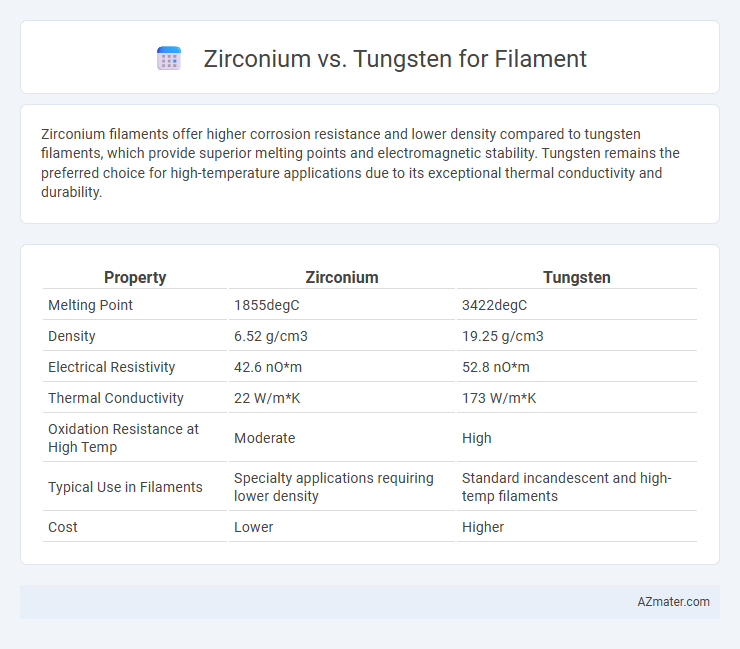Zirconium filaments offer higher corrosion resistance and lower density compared to tungsten filaments, which provide superior melting points and electromagnetic stability. Tungsten remains the preferred choice for high-temperature applications due to its exceptional thermal conductivity and durability.
Table of Comparison
| Property | Zirconium | Tungsten |
|---|---|---|
| Melting Point | 1855degC | 3422degC |
| Density | 6.52 g/cm3 | 19.25 g/cm3 |
| Electrical Resistivity | 42.6 nO*m | 52.8 nO*m |
| Thermal Conductivity | 22 W/m*K | 173 W/m*K |
| Oxidation Resistance at High Temp | Moderate | High |
| Typical Use in Filaments | Specialty applications requiring lower density | Standard incandescent and high-temp filaments |
| Cost | Lower | Higher |
Introduction to Filament Materials: Zirconium vs Tungsten
Zirconium and tungsten are prominent materials used for filaments in high-temperature applications due to their exceptional melting points and durability. Tungsten boasts a melting point of 3422degC, making it the preferred choice for incandescent light bulbs and electron emitters, while zirconium, with a melting point of approximately 1855degC, offers superior corrosion resistance and chemical stability. The selection between zirconium and tungsten filaments depends on application-specific requirements such as operating temperature, mechanical stress, and environmental conditions.
Physical and Chemical Properties Comparison
Zirconium exhibits high corrosion resistance and a melting point of approximately 1855degC, making it ideal for applications requiring durability in reactive environments. Tungsten possesses a superior melting point of 3422degC and exceptional tensile strength, enabling it to withstand extreme temperatures in filament applications. Chemically, zirconium forms a stable oxide layer enhancing its oxidation resistance, while tungsten's oxide is volatile at elevated temperatures, affecting filament longevity.
Electrical Conductivity: Which Filament Performs Better?
Tungsten exhibits superior electrical conductivity compared to zirconium, making it the preferred choice for filament applications in incandescent bulbs and electron emission devices. Its conductivity, coupled with an exceptionally high melting point of 3422degC, ensures efficient current flow and durability under high temperatures. Zirconium's lower conductivity and lower melting point render it less efficient for high-performance filament use.
Melting Point and Thermal Stability
Zirconium filaments exhibit a melting point of approximately 1855degC, offering good thermal stability for moderate high-temperature applications. Tungsten filaments surpass zirconium with a melting point near 3422degC, providing exceptional thermal stability and resistance to deformation under extreme heat. This makes tungsten the preferred material for filament use in high-intensity lighting and industrial heating elements where superior heat endurance is critical.
Mechanical Strength and Durability
Zirconium filaments exhibit superior mechanical strength due to their high melting point of 1855degC and excellent resistance to thermal shock, making them highly durable in demanding applications. Tungsten filaments offer exceptional durability with the highest melting point among metals at 3422degC, allowing them to sustain extreme temperatures without deformation. Mechanical strength in tungsten is enhanced by its density and tensile strength, while zirconium provides better flexibility and resistance to oxidation at elevated temperatures.
Corrosion and Oxidation Resistance
Zirconium exhibits superior corrosion and oxidation resistance compared to tungsten, making it more durable in high-temperature filament applications. Tungsten, while having a higher melting point, oxidizes rapidly at temperatures above 400degC, which limits its lifespan unless protected in inert or vacuum environments. Zirconium's oxide layer forms a stable barrier that significantly reduces degradation, ensuring enhanced longevity and performance in oxidative atmospheres.
Efficiency and Lifespan in Lighting Applications
Tungsten filaments exhibit higher efficiency and longer lifespan compared to zirconium due to tungsten's superior melting point of 3422degC, enabling sustained incandescent performance and reduced evaporation rates. Zirconium, with a melting point of 1855degC, offers less durability and efficiency under high temperatures, making it less suitable for prolonged lighting applications. Consequently, tungsten remains the preferred material for filament manufacturing, optimizing both energy efficiency and operational longevity in lighting technologies.
Cost Analysis: Zirconium vs Tungsten Filaments
Zirconium filaments generally exhibit higher initial costs compared to tungsten due to the rarity and complex extraction processes of zirconium alloys, impacting overall manufacturing expenses. Tungsten filaments benefit from established large-scale production and widespread availability, resulting in lower material costs and more competitive pricing in industrial applications. Cost analysis favors tungsten for budget-sensitive projects, while zirconium may justify its premium in specialized uses requiring superior thermal stability and corrosion resistance.
Environmental and Safety Considerations
Zirconium filaments offer lower toxicity and reduced environmental impact compared to tungsten due to their less hazardous oxidation products and greater recyclability. Tungsten filaments, while highly durable and heat-resistant, pose environmental challenges due to their energy-intensive mining and processing, as well as potential release of harmful particulates during use and disposal. Safety protocols for handling zirconium are generally less stringent, minimizing occupational health risks versus tungsten's stricter controls owing to its brittle dust and potential carcinogenicity.
Conclusion: Choosing the Best Filament Material
Zirconium offers superior thermal stability and corrosion resistance compared to tungsten, making it ideal for high-temperature filament applications where longevity is crucial. Tungsten excels in electrical conductivity and melting point, providing exceptional performance in environments requiring high heat and electrical efficiency. Selecting the best filament material depends on balancing the need for durability and thermal resistance (favoring zirconium) against maximum electrical and heat performance (favoring tungsten).

Infographic: Zirconium vs Tungsten for Filament
 azmater.com
azmater.com